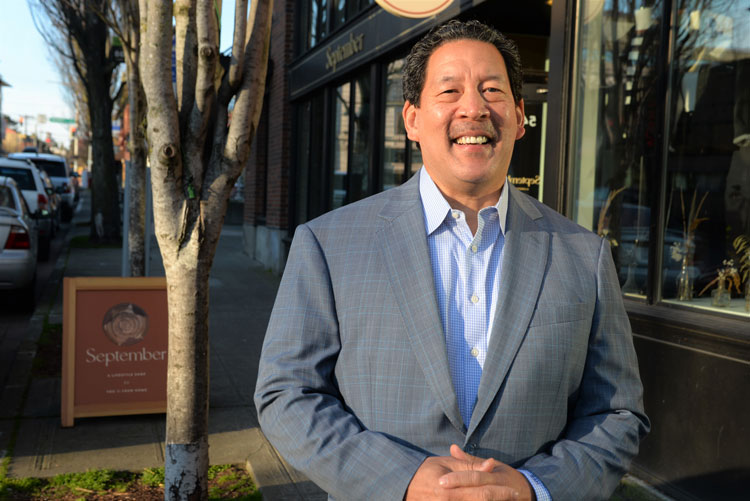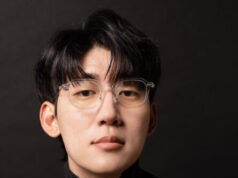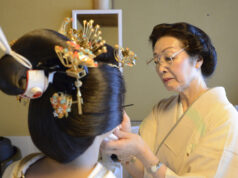Interview by Elaine Ikoma Ko
Special for The North American Post
Photos courtesy of Harrell family
Bruce Harrell is a candidate for Seattle Mayor in the August 3 primary election
www.bruceforseattle.com
Experience: Seattle City Council, 2007-2019; attorney, private practice
Education: Garfield High School, University of Washington
Ethnicity: African American and Japanese American
Email: info@bruceforseattle.com
@bruceforseattle (Facebook, Twitter, Instagram)
Bruce Harrell, former Seattle City Council member for twelve years (2007-2019), has rare life experience as a biracial child of an African American father and Japanese American mother. Growing up in Seattle in the 1960s-70s, his background has shaped his outlook, his family values, and ultimately, his vision for Seattle as he runs for mayor this summer and fall. If elected, he would be Seattle’s second Black and first Asian American mayor.

Please tell us about your family’s history in Seattle — starting with your grandparents and then how your father met your mother.
My Japanese grandmother was Tameno Habu-Kobata. She was born in Osaka, Japan and married Teiji Habu. They came to Seattle in the early 1900s and had six children: Jack, Kimi, John, Yuki, Kako, and Mary. They lived in Seattle’s Central Area and opened a small grocery store.

Many Seattleites remember the old Garland Florist near 10th and South Jackson Street, run by Kako (Habu) Shinbo and her husband “Doc” Shinbo. People may also remember Jack Habu’s successful auto repair shop located off South Jackson Street. Today, it is still run by his sons, Art and Gordon Habu.
Grandpa Habu died at a young age from meningitis. On his death bed, he asked his best friend, John Kobata, to take care of his wife and six children. John did so and my grandmother Tameno eventually married him. From her second marriage came five more children: George, Louise, Frank, George, and my mother Rose, their youngest. Rose’s father was a florist, thus the name “Rose.” There were two “Georges” because the first one died very early.

My mother’s sister, Louise (Kobata) Sakuma, ran Cherryland Florist at 12th and Yesler Way in the Central Area for decades. Today, she resides not far from the area. All of these family members were incarcerated in the Minidoka incarceration camp during WWII, including my mother Rose.
After incarceration, my mother attended Seattle’s Garfield High School and met my father, Clayton Harrell, Sr., there. My father’s family had moved to Seattle from New Orleans, Louisiana. His father, William Harrell, was a carpenter who built his own home in Seattle’s Madison Valley. Two of his three sons graduated from the University of Washington (UW) with graduate degrees in the 1950s. My grandmother, Lillian Harrell, was a Licensed Nurse Practitioner at First Hill’s Cabrini Hospital in the newborn unit.
My parents graduated from Garfield in 1951 and got married in 1953 so, of course at the time, family members on both sides were concerned. Many of mom’s siblings did not openly embrace my father as an African American, but over the years, he charmed them all.
Legendary music composer Quincy Jones was in their high school class and my father played with him in a band known as Bumpy Blackwell’s Band. They were legendary in Seattle.
Marrying out of their races at the time, my parents faced stares and doubt from every vantage. I recall walking the streets of downtown seeing people stare at my father, my mother, and then my brother and me as though we were from another planet. But my parents never left each other’s sides through five decades of marriage and truly lived the motto “till death do us part.”
Please tell us more about your Nikkei mother, her growing up, her career as an adult.

My mother, Rose Tamaye Kobata, was born on July 17, 1933 in Seattle and as noted, was the youngest of 11 children. She attended the Central Area’s Bailey Gatzert Elementary School, Washington Middle School, and Garfield, and took some classes at the UW in accounting.

She was both mother and career woman. She worked as a secretary at the East Madison YMCA, at “The Facts“ (local African American newspaper, still in operation today), and as a business manager for the Seattle Model Cities program under Walter Hundley. The majority of her career was as finance manager at the Seattle Public Library.
My mother passed away on October 14, 2014, from heart failure at age 81. My wife, Joanne, and I were with her the day before, enjoying a football game, and her sense of humor, feistiness and joy were with her to her very last breath.
What was it like growing up in a Black/Japanese biracial family in the 1960s and 1970s? What instances of both acceptance and/or discrimination do you recall?
Growing up, I always questioned where I fit in relation to racial groups. I had to check two boxes in forms asking for “race” and when asked to participate in discussions regarding “race” in those days, I was hesitant to speak out knowing that others had different experiences than I had.
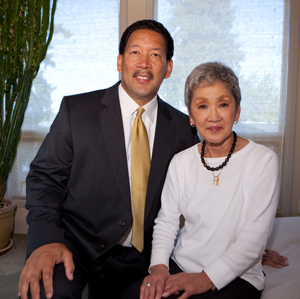
It was not until I was a student at UW where I started to meet more and more mixed-race people and I was quite excited about befriending them. But what I remember most, aside from the challenges, was how I had friends from every race and background who loved and respected me. I learned at an early age that the fuel to keep in my tank was the love that always surrounded me. When someone says something hurtful, I rely on those positive influencers in my life that keep me energized. I feed off of that even today, regardless of what race they are.
My mother, who was indeed a “superwoman,” provided me and my older brother, Clayton, Jr., with the love, confidence, and armor to deal with the ignorance and negative judgments that we would face being biracial. As a kid, I was called unimaginable names, often resulting in fights.
That love, coming from a Japanese mother and a Black father, fuels me even after they have both physically departed from this earth. And today, even with all the anti-Asian hate and violence against Black, Indigenous, and People of Color (BIPOC), I still resort to love as my shield and armor.
Proudly, I have a beautiful wife, Joanne, three children and two grandchildren, and many wonderful nieces and nephews — all boasting diverse ethnic and cultural backgrounds.
Were your parents your greatest role models as you navigated growing up in Central Seattle and among other accomplishments, as you became a Garfield class valedictorian and later, a UW football player?
I loved my father as much as a son could love a father and he was a good father to me. He died of cancer in 2003. He was a great man.
But I attribute my confidence, athletic ability, mental toughness, and spiritual foundation to my mother.
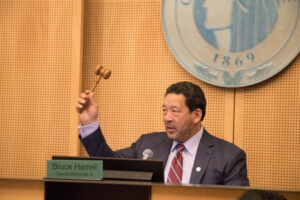
My mother loved to read and she made me read to her out loud every night as a child while she would wash the dishes by hand. I would finish a book only to start another book, day after day, year after year. She impressed upon me the need to learn and to be curious about things.
She taught Sunday school in church and helped with Women’s Day. When I was a child, she was active in the PTSA (Parent Teacher Student Association). She never missed a game in any sport that I was involved in. I would tell her that I wanted to start early morning workouts and she would wake me up to do it. She would make sure I would sleep, study, and plan. She set high expectations for me and I always watched how hard she worked. She would rise early, fix breakfast, work all day, fix dinner, and clean the kitchen by herself. I would help her clean the kitchen as I got older because the woman had more stamina than anyone I knew.
One day in high school, I was in a wrestling tournament at 190 pounds weight. I won the first match and she waited for me in the car for four hours to give me a ride home.
When I got in the car, she said, “What took you so long?”
I said, “What do you mean, I ran out here right after the match.”
She said, “That was like four hours ago.”
I said, “Mom, I had two more matches. It’s a tournament. I won them. Didn’t you see?”
She said, “No, I was reading a book.”
But she never complained. Yet, here I was I complaining that she didn’t see me and she was the only family member there. So, she took me to get burgers and we laughed about it. She was the dynamo in my life.
What was the key inspiration for you to first run for office on the Seattle City Council in 2007?
My key inspiration to run for office in 2007 was that it was simply my time to serve. I had previously worked for the City Council in 1980. By 2007, I had experienced great success as a lawyer and business owner and I had vast experience in working with so many clients over the decades, including employees, employers, nonprofits, technologists, professionals, laborers, educators, community groups, clubs and churches — you name it. I felt that my experience in what it takes to build a pathway to success would be of benefit to the City and that I could implement policies to build that pathway.
You have served for many years on the Seattle City Council and as Council President. What would you say are your most lasting legacies and perhaps most rewarding accomplishments?
Having served for twelve years, I sponsored or co-sponsored many pieces of legislation. Several stand out as ones I am very proud of.
In 2013, I was the sole sponsor of the Job Assistance Bill, also known as “Banning the Box,” which enhanced opportunities during job interviews for individuals with past criminal backgrounds while not jeopardizing the safety of other employees or customers of the employer. Seattle has over 120,000 people with arrest records; over 420,000 people in King County have criminal convictions. Before this groundbreaking legislation, many members of our society were not even afforded the opportunity to explain what they were arrested for, for example, a minor drug offense many years before their job application. I am very proud of this legislation.
In 2010, I developed “The Great Student” initiative that rigorously evaluated disparities in technology access and specifically targeted Seattle Public School students on the free- and reduced-lunch program. I championed the initiative to provide 20,000 SPS students access to computers and high-speed internet access for less than $10/month. The idea came from when I was tutoring kids at Seattle’s Madrona Middle School. For it, I was awarded the prestigious “Broadband Visionary of the Year Award” in Washington, D.C. by the National Association of Telecommunication Advisors and Officers Association.

I was the first elected official to propose and establish a City of Seattle partnership with South Seattle College to allow graduating high school seniors to attend SSC tuition free. I successfully placed $1.5 million in the 2017-2018 City budget for what was known as the “13th Year Promise.” Subsequently, Mayor Jenny Durkan announced a $5 million endowment to cover the tuition costs of future 13th year students and expand the program citywide. In 2021, President Biden announced his similar “community college free for all” platform as part of his national strategy.
I was a key elected official and member of Seattle’s Inequality Advisory Committee to increase the minimum wage to $15 per hour, which took effect in 2015. On this, I worked collaboratively with employee advocacy groups, business owners and leaders, non-profit organizations, human service organizations, restaurant workers, hospitality organizations, and workers and businesses in the industrial and manufacturing job sector.
Public testimony from David Freiboth, from the Martin Luther King County Council, stated: “Councilmember Harrell is one of the unsung key people in the minimum wage campaign. A lot of people took a lot of credit… and a lot of people didn’t give enough credit for what you did in that committee. So I just want to thank you for that.”
My commitment to public safety is unprecedented. As a Public Safety Chair, I funded more police officers each year and reached 1,384 sworn officers by the end of 2016, the highest ever for the police department in city history.
The following year, in 2017, to ensure that more police officers did not equate to increased levels of police misconduct or their use of unreasonable force, I was the sole drafter of Seattle’s first “Bias Free” policing law, which became effective in 2019. It creates a private right of action for persons alleging to be a victim of racist or biased policing. It requires the City to collect specific data regarding “Terry” stops (police briefly stopping someone for a reasonable suspicion of criminal activity) and traffic stops to evaluate issues of racial profiling. It requires the Seattle Police Department to undergo specific training on Bias Free policing. All of these requirements will remain in force long after the federal consent decree overseeing the police department’s use of excessive force, which began in 2012, expires.
You have run, unsuccessfully, for mayor in the past. What is the prime motivation for you to run for mayor this year? Can you highlight your top vision and priorities especially in light of these most challenging times?
My prime motivation is that Seattle, the city I love, the city that has helped me achieve the dreams of my youth, and the city in which I raised my children, is at an all-time low point in my view. I am willing to serve the public with all of my energy, experience and passion to reset, rejuvenate, and revitalize it. I believe my personal heritage, my personal and professional experiences, my faith and the relationships I have spent a lifetime building, make me an ideal candidate to address the issues Seattle is now facing.
My vision can be captured through three overarching themes/priorities: Race and Social Justice, Economic Revitalization, especially for our ravaged small businesses, and Public Safety/Homelessness. I put the last two together as they are integrally linked. Obviously, there is a lot more to be said about these themes and I hope that readers will seek out more about my policy priorities, as well as my history of accomplishments.
What was your first visit to Japan like?
My first trip to Japan was with the Japanese American Leadership Delegation (JALD) in 2016 and was one of the most educational and life-changing experiences I had ever had. It was simply amazing to be able to shake hands and converse with the Prime Minister, meet with members of their federal congress or National Diet, meet with the Japanese royal family, and meet with ordinary Japanese families who want to improve relationships with Americans. The visit really helped me better understand my own culture and how a small island country could have such an established place in the world order.
What messages would you have for biracial/multiracial young people starting out their careers or considering political office?
My message for every biracial or multi-racial young person thinking about their career is to first know that your most powerful tools will be who you know, who you have relationships with, and what you read. The beauty of this strategy is that you have control over these things. Help as many people as you can if you believe in their ultimate goal. In the long run, it pays in dividends. And then, read everything you can about trends, answers, solutions and be the one in the group to volunteer in working on them. Perhaps last, and most importantly, try to keep the most positive attitude you can. At the end of the day, you will be defined by the attitude you bring. Again, this is something that ultimately is your choice.

